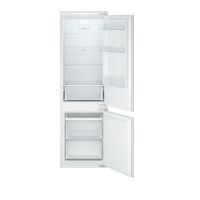ENGLISH 13
Operation
Control panel
1
2
1
Temperature indicator
2
Function button
Switching on
Warning! Refer to "Electrical
connection" section of the Safety
chapter.
Connect the mains plug to the power socket.
The display on the control panel turns on. To
change temperature, refer to the section for
temperature regulation.
When operating the appliance for the
rst time, set the appliance at a colder
temperature and run it without loading any
food until it auto stops at the set temperature.
Usually it takes 2 or 3 hours, then set a desired
temperature and put food in the appliance.
Do not use sharp object to control the touch
panel.
Switching o
• To switch the appliance o, press and hold
the
2
Function button on the control
panel for 10seconds. After 30seconds, the
appliance will switch o all loads are turned
o, and the display and control of the
refrigerator will be all o in the power o
mode.
• To switch the appliance on again, press the
2
Function button.
To disconnect the appliance from the power
supply, disconnect the mains plug from the
power socket.
Locking/unlocking
• If the door is closed and no button
operation occurs for 30 seconds, the control
panel will be locked. Button operation is
invalid.
• To unlock the control panel, press and hold
the
2
Function button on the control panel
for 3seconds. Button operation is available.
Temperature regulation for refrigerator
compartment
• Press the
2
Function button on the control
panel to toggle a preset temperature.
The four LEDs indicated from ** to *
corresponds to the following temperatures:
2°C, 4°C, 6°C and 8°C. The appliance will run
at the newly set temperature 30seconds
later.
Adjust the temperature setting by keeping
in mind that the temperature inside the
appliance depends on:
• room temperature
• how often the door is opened
• the quantity of food stored
• the location of the appliance
Important! If the ambient temperature is
high or the appliance is fully loaded, and the
appliance is set to the lowest temperatures, it
may run continuously causing frost to form on
the rear wall. In this case a higher temperature
must be set to allow automatic defrosting and
therefore reduced energy consumption.

